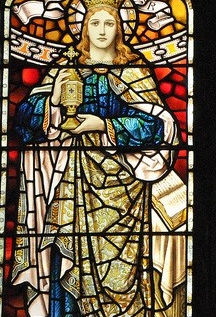
St. Margaret, Queen of Scotland
Known as “The Pearl of Scotland” our Patron and Namesake Saint was born to an English Prince in exile in Hungry in 1045. Her mother was either German or Hungarian, but her father Edward was a direct descendant of the old Anglo-Saxon house of Wessex. The family returned to England in 1054 in the hopes that Edward would be recognized as the heir to King Edward the Confessor. However, when King Harold II fell at Hastings, and Margaret’s brother Edgar Ætheling was elected King; he was never Crowned as William the Conqueror was Crowned William I and had Edgar imprisoned. After his death and the Norman conquest of England, it became clear that Margaret’s family would not succeed to the English throne.
Quite why she and her mother, sister and brother came to Scotland is not clear, but the family landed in Fife in 1068 and were welcomed by the King of Scots, Malcolm III, whose palace was nearby at Dunfermline. Malcolm and Margaret were married in Dunfermline in 1070 and had 8 children, 6 boys and 2 girls. Edward, the eldest, was killed with his father at Alnwick, Ethelred became Abbot of Dunkeld, Edmund, according to Turgot, 'fell away from the good', Edgar, Alexander and David successively became kings of Scotland. Matilda (known sometimes as Maud), the elder daughter, married Henry I of England, and their daughter, also Matilda, married the Emperor Henry V. Mary, the younger daughter, married the Count of Bologne, and their daughter also became a queen of England as the wife of King Stephen.
Margaret had been brought up in Christian courts, first in Hungary and then in England, especially in the discipline of the Benedictines and she founded a Benedictine abbey in Dunfermline. She lived her life according to this rule, with an emphasis on prayer, fasting, and caring for the poor. She showed respect for the native Celtic church, and, with the support of her husband, managed to reconcile its practices with those of the Roman church.
Sadly, merely days after receiving news of her husband and eldest son’s death in battle she died on 16 of November 1093. It is said she died of a broken heart. An account of her life was written by the monk Turgot at the request of her daughter Edith shortly after her death and she was canonized in 1250. However, in Scotland she had been called “Saint” since her death. The best-known miracle associated with St. Margaret was the preservation of her gospel book which had fallen into a river, and her shrine at Dunfermline was the scene of several miracles of healing.
The Black Rood of St. Margaret was of her most prized possessions. This rood, or cross, which was said to contain a fragment of the true Cross, was encased in ebony and heavily decorated. In the generations after Queen Margaret, the Black Rood, along with the Stone of Scone, became a symbol of Scottish sovereignty, but for her it was an object of devout veneration, and she is said to have been holding it when she died in Edinburgh Castle soon after hearing of the deaths of her husband and eldest son at the Battle of Alnwick in 1093.
Queen Margaret spent much of her married life in Dunfermline. Remains of the abbey which she founded can still be seen, and St. Margaret's Cave where she spent many hours alone in prayer, and St. Margaret's Stone where she sat to offer guidance and comfort, together with other locations and artifacts associated with her, are lovingly maintained.
Seen as the apex of pious Christianity and compared to the English St. Edward the Confessor, depictions of St. Margaret generally show her both as a Queen and a pious omen. Often tying in images and effects of a nun, and her acts of piety and charity in paintings. Below are a collection of paintings and windows showing this.
Many buildings, colleges, schools, societies, and organizations are named in honor of St. Margaret of Scotland. We are no different and we felt there was no one better to try and hold as our role model, than her. The oldest standing portion of Edinburgh Castle is St. Margaret’s Chapel, built in 1130 by David I, one of the sons of St. Margaret, pictured below as well.
Her elevation to the Calendar of Saints was probably unique at the time, for she was neither a virgin nor a martyr (the most usual qualifications for sainthood) but a wife and a mother. And it is as a wife and a mother, as well as a caring, compassionate Queen, that she is remembered today.
Click on Pictures Below to Enlarge



















